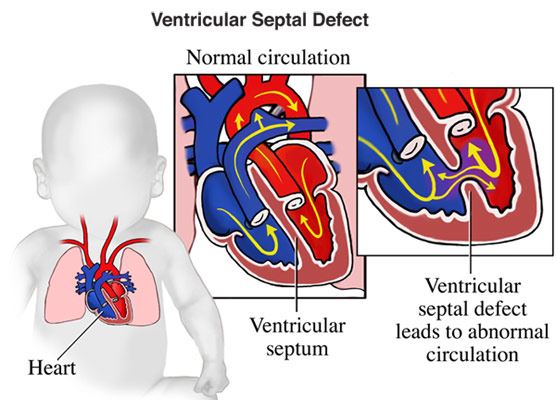Ventricular Septal Defects
The normal heart is composed of four chambers. The upper chambers are called “right and left atria” while the lower chambers are called “right and left ventricles.” The right atria receives deoxygenated blood from systemic veins; the left atrium receives oxygenated blood from the pulmonary veins. The right ventricle pumps the blood into the pulmonary artery and lungs. The left ventricle receives oxygenated blood from the left atrium and then pumps it through the aorta and to the rest of the body.
Separating the lower chambers is a muscular wall called the septum. If there is a hole or defect in the septum it is called a ventricular septal defect (VSD). VSD is a type of congenital heart defect (present at birth). In this condition, oxygenated blood from the left ventricle flows through this hole into the right ventricle (non-oxygenated blood). This mixture causes an increase in the amount of blood flowing toward the lungs. If not properly addressed, it can lead to heart failure, pulmonary hypertension or heart arrhythmias.

Medical Illustration Copyright © 2019 Nucleus Medical Media, All rights reserved.
Causes of Ventricular Septal Defects
Doctors know that heart defects present at birth (congenital) arise from errors early in the heart's development, but there's often no clear cause.
Symptoms of Ventricular Septal Defects
Many people born with this condition have no signs or symptoms. However, as the condition worsens symptoms may start to appear. Some of these symptoms include:
- Shortness of breath, especially when exercising.
- Fatigue
- Swelling of legs, feet or abdomen.
- Heart palpitations
- Heart murmurs
Diagnosis of Ventricular Septal Defects
To diagnose this condition, your doctor will perform a variety of diagnostic tests, including but not limited to:
- Echocardiogram (ECHO)
- Cardiac catheterization
- Computed tomography (CT scan)
- Magnetic resonance imaging (MRI)
- X-Rays
- Electrocardiogram (EKG/ECG)
Treatment of Ventricular Septal Defects
Many ventricular septal defects close on their own during childhood. For those that don't close or those that are small, treatment may not be required. However, it is very important to keep it monitored. Moderate or large VSDs may eventually require surgery. Some treatment options include:
Medications
Though they will not be able to repair the hole, medications can reduce some of the signs and symptoms present for those with a ventricular septal defect. Drugs may also be used to reduce the risk of complications after surgery.
- Beta blockers will help reduce your blood pressure.
- Diuretics will help reduce the amount of excess fluid.
